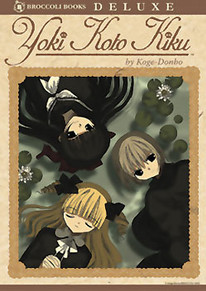Review
by Carl Kimlinger,Yoki Koto Kiku
| Synopsis: |  |
||
When the head of the wealthy Nekogami family passes away, he wills his entire fortune to his eldest grandson Sukekiyo. Sukekiyo, however, is away at war and if he doesn't return in time, the goods get passed on to one of his three siblings—the triplets Yoki, Koto and Kiku—or to Sukekiyo's fiancée, the Nekogami's maid Tamayo. Thus the stage is set for a sibling rivalry of murderous magnitude. But first they need to take care of any interlopers, and that means targeting Tamayo and anyone else who gets too close to the family fortune (or Tamayo), be they detective, thief or shinigami. Yes, it's war, and the corpses will pile to the sky. Okay, perhaps it'll just be the odd one here and there. But it won't be for lack of trying. |
|||
| Review: | |||
The appeal of Koge Donbo's one-shot dark comedy can be summed up with a single phrase: Superdeformed murder. If this sounds to you like a tenuous basis for a good manga, you'd be right. It is. Koge Donbo states in the afterword that she was motivated solely by a desire to create a black comedy with cute characters. This ambition permeates the entire work, but in puruing this goal, she has apparently let the plot and character slide, as they are, at best, perfunctory and, at worst, nonsensical. The characters start out as thumbnail character sketches (Yoki the shy traditional beauty; Koto the frail bishounen; Kiku the bubbly girl-child; Tamayo the clueless maid) and resolutely refuse to develop anything more than rudimentary quirks (outside of the exposure of everyone's—sans Tamayo—truly magnificent vicious streaks that is). The fact that all of the principal players (once again sans Tamayo) are shallow, self-interested, and utterly unlikable is beside, or perhaps more accurately, exactly the point, as the lion's share of the humor—true to Koge Donbo's stated intent—is highly dependent on absolutely adorable characters doing absolutely atrocious things to each other. The plotting, such as it is, follows the same route as the characters, and quickly falls into a formula in which an unsuspecting individual finds themselves entangled in the Nekogami's inheritance dispute and suffers most grievously for the inadvertent trespass. In all fairness, however, Yoki Koto Kiku is a comedy, and comedies, pardon the pun, live or die by their humor. Which is to say; if the jokes are funny, everything else can go to hell. Such are the rules of comedy. On this level, Yoki Koto Kiku works. For a while. The first couple of chapters all feature a few good chuckles and at least one laugh-out-loud moment (the climax of Chapter 2 being particularly hilarious). But the repetitive nature of the plotting quickly grows tiresome and the super-deformed attempted murder can only be milked for so many laughs. Later attempts to liven things up with missiles, masked thieves and shinigami only serve to sabotage the Agatha-Christie-meets-Di-Gi-CHARAT atmosphere that gives the first half its oddball charm. And then there's the muddled, pointless and—most unforgivable—unfunny final chapter. Tying up a short work is often problematic in manga, but it could have a least been funny, right? Everything that is good about this title—i.e. the effective sight gags—is, no surprise, directly traceable to the artwork. Koge Donbo's round-faced, perpetually chibi character designs will probably never be for all tastes, but they work well in this context, with the contrast between the appearances and actions of the characters serving as background humor to the occasional masterfully staged visual gag (usually involving collateral damage to secondary characters). The designs are all varied enough to make distinguishing characters from each other a simple task, and back grounds, while frequently obscured or absent, are well-rendered when present and used effectively throughout to give a sense of place to each scene. Panel layout is sensible and easy to follow, with enough variation in size and placement of the panels to keep it from being boring. All panel borders are solid black, adding a slight gothic feel to the pages. As always, Broccoli Books did a superb job with the presentation of this volume. The inking is smooth and uniform and the omnipresent areas of solid black are all flawlessly rendered. Extras include a glossy color cover-page, a brief afterword by the author, a preview of Koge Donbo's upcoming work Kon Kon Kokon, and extensive translator notes that are chock full of useful information, such as an overview of the book that the manga parodies, the meanings of the triplets' names, and why Sukekiyo looks so familiar. The binding is sturdy and the pages are all printed on heavy, high-quality paper, giving the book a nice heft; ironically making it perfect for throwing at your siblings. Yoki Koto Kiku would probably fare better in serialized form. When collected into a single volume the repetitiveness of the chapters becomes far too obvious, dulling the edge of the humor and eventually destroying much of the enjoyment. Nevertheless, the short nature and excellent production values of this book make it a good buy for Koge Donbo fans or fans of the macabre who don't mind the lack of depth. It's just that there's better black humor out there, and, for that matter, better Koge Donbo manga. |
| Grade: | |||
|
Overall : C
Story : C-
Art : B
+ One killer gag, enjoyable art. |
|||
| discuss this in the forum (1 post) | | |||
| Production Info: | ||
|
Full encyclopedia details about |
||